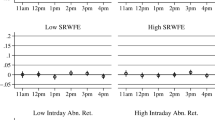Abstract
This study analyzes the effects of listing changes within NASDAQ market segments during the period of 1998 to 2005. We find that firms phased up from the NASDAQ Small Capital Market (SmallCap) to the NASDAQ National Market (NNM) experienced significant declines in bid-ask spreads, the volatility of returns, and the probability of informed trading, and firms that phased down from NNM to the SmallCap experienced decreases in bid-ask spreads, but insignificant changes in the volatility of returns and the probability of informed trading. We also estimate simultaneous equations models of bid-ask spreads, return volatility, and trading volume for both groups of firms. The results confirm that improved liquidity is associated with the listing changes for the phase-up firms. However, the simultaneous equations model suggests that the decreases in bid-ask spreads for the phase-down firms are caused by the changes in share prices.
Similar content being viewed by others
Notes
National Association of Securities Dealers, Inc. (NASD) Rule 3350, or NASD Short Sale Rule, was approved by the Securities and Exchange Commission (SEC).
In 1984, the Federal Reserve Board ruled that NASDAQ/NMS securities automatically qualified for purchase in margin accounts, like issues listed on the NYSE and AMEX.
Blue Sky Laws: State regulations designed to protect investors against securities fraud by requiring sellers of new issues to register their offerings and provide financial details. This allows investors to base their judgments on trustworthy data.
A value of 1 indicates the stock was included in the SmallCap Market before June 15, 1992, and a value of 3 indicates the stock was included in the SmallCap after June 15, 1992.
References
Amihud Y, Mendelson H (1988) Liquidity and asset prices: financial management implications. Financ Manage 17(1):5
Baker HK, Edelman RB (1990) OTC market switching and stock returns—some empirical-evidence. J Financ Res 13(4):325–338
Barclay MJ (1997) Bid-ask spreads and the avoidance of odd-eights quotes on NASDAQ: an examination of exchange listings. J Financ Econ 45(1):35–60
Barclay MJ (1999) The effects of market reform on the trading costs and depths of NASDAQ stocks. J Fin 54:1
Barclay MJ, Hendershott T (2003) Price discovery and trading after hours. Rev Financ Stud 16(4):1041–1073
Bennett P, Wei L (2006) Market structure, fragmentation and market quality. J Financ Mark 9(1):49–78
Bessembinder H (1999) Trade execution costs on NASDAQ and the NYSE: a post-reform comparison. J Financ Quant Anal 34(3):387–407
Bessembinder H (2003) Quote-based competition and trade execution costs in NYSE-listed stocks. J Financ Econ 70:385–422
Christie WG, Schultz PH (1994) Why do NASDAQ market makers avoid odd-8th quotes. J Financ 49(5):1813–1840
Christie WG, Harris JH, Schultz PH (1994) Why did NASDAQ market makers stop avoiding odd-8th quotes. Journal of Finance 49(5):1841–1860
Easley D, Kiefer NM, O’Hara M (1996a) Cream-skimming or profit-sharing? The curious role of purchased order flow. J Financ 51(3):811–833
Easley D, Kiefer NM, O’Hara M, Paperman JB (1996b) Liquidity, information, and infrequently traded stocks. J Financ 51(4):1405–1436
Elyasiani E, Hauser S, Lauterbach B (2000) Market response to liquidity improvements: evidence from exchange listings. Financ Rev 35(1):1
Grossman SJ, Miller MH (1988) Liquidity and market structure. J Financ 43(3):617–633
Hamilton JL (1976) Competition, scale economies, and transaction cost in the stock market. J Financ Quant Anal 11(5):779–802
Huang R, Stoll H (1996) Dealer versus auction markets: a paired comparison of execution costs on NASDAQ and the NYSE. J Financ Econ 41:313–357
Karpoff J (1986) A theory of trading volume. J Financ 41:1060–1088
Lee C, Ready M (1991) Inferring trade direction from intraday data. J Financ 46:733–747
Madhavan A (1995) Consolidation, fragmentation, and the disclosure of trading information. Rev Financ Stud 8(3):579–603
Mendelson H (1987) Consolidation, fragmentation, and market performance. J Financ Quant Anal 22(2):189–207
Pagano M, Roell A (1996) Transparency and liquidity: a comparison of auction and dealer markets with informed trading. J Financ 51:33
Rindi B (2008) Informed traders as liquidity providers: anonymity, liquidity and price formation. Rev Financ 12(3):497–532
Tauchen G, Pitts M (1983) The price variability-volume relation on speculative markets. Econometrica 51:485–505
Viswanathan KG, Papaioannou G, Krull S (1997) Testing for liquidity gains in the market reaction to NASDAQ national market system phase-ins. Q J Bus Econ 36(3):49–61
Weston JP (2000) Competition on the NASDAQ and the impact of recent market reforms. J Financ 55(6):2565–2598
Acknowledgement
The authors would like to thank the editor and an anonymous referee for their comments which significantly improved the focus of the paper. The authors also thank William F. Chappell, Jon Moen, Simona Lup Tick and Robert A. Van Ness for their helpful comments and suggestions. The views expressed are those of the authors and they assume full responsibility of all errors and omissions.
Author information
Authors and Affiliations
Corresponding author
Rights and permissions
About this article
Cite this article
Tang, W., Nguyen, H.H. & Nguyen, V.T. The effects of listing changes between NASDAQ market segments. J Econ Finan 37, 584–605 (2013). https://doi.org/10.1007/s12197-011-9198-3
Published:
Issue Date:
DOI: https://doi.org/10.1007/s12197-011-9198-3




